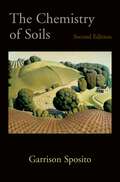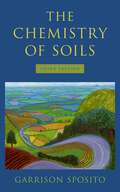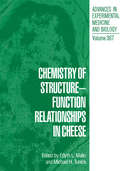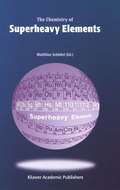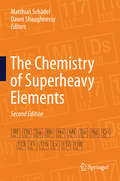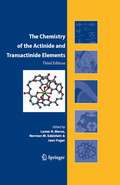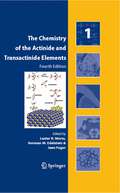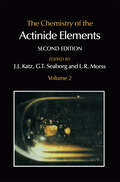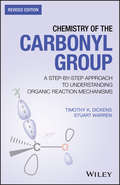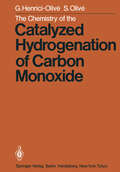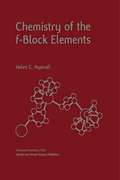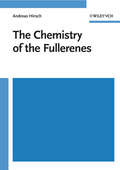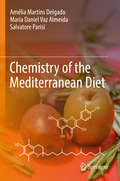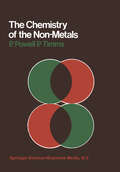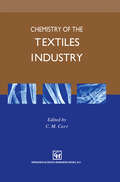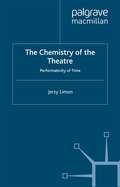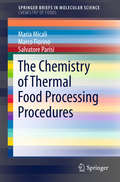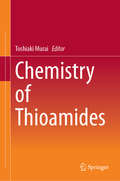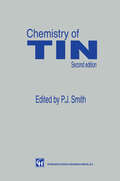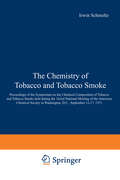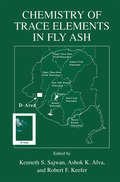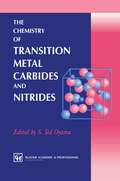- Table View
- List View
The Chemistry of Soils
by Garrison SpositoThere have been many advances in soil chemistry since Oxford published the first edition of The Chemistry of Soils in 1989. The physical-chemistry approach to soil chemistry taken in the book, groundbreaking for its time, has been adopted by nearly every soil chemistry book published since. This book offers a thorough update of all topics covered in the previous edition. In the last 16 years, soil chemistry as a discipline has assumed major significance in connection with global climate change. The 2nd edition addresses the emergent issue of global climate change by exploring the interaction between organic carbon and soil. The largest repository of organic carbon on earth is still soil, and the process by which organic carbon is sequestered by soil, thus preventing the release of carbon dioxide into the atmosphere, is one of the proper concerns of soil chemistry. Thus, the revision provides a rigorous discussion of soil chemistry in its broader environmental and biogeochemical contexts.
The Chemistry of Soils
by Garrison SpositoThe second edition of The Chemistry of Soils, published in 2008, has been used as a main text in soil-science courses across the world, and the book is widely cited as a reference for researchers in geoscience, agriculture, and ecology. The book introduces soil into its context within geoscience and chemistry, addresses the effects of global climate change on soil, and provides insight into the chemical behavior of pollutants in soils. Since 2008, the field of soil science has developed in three key ways that Sposito addresses in this third edition. For one, research related to the Critical Zone (the material extending downward from vegetation canopy to groundwater) has undergone widespread reorganization as it becomes better understood as a key resource to human life. Secondly, scientists have greatly increased their understanding of how organic matter in soil functions in chemical reactions. Finally, the study of microorganisms as they relate to soil science has significantly expanded. The new edition is still be comprised of twelve chapters, introducing students to the principal components of soil, discussing a wide range of chemical reactions, and surveying important human applications. The chapters also contain completely revised annotated reading lists and problem sets.
The Chemistry of Soils
by Garrison SpositoThe second edition of The Chemistry of Soils, published in 2008, has been used as a main text in soil-science courses across the world, and the book is widely cited as a reference for researchers in geoscience, agriculture, and ecology. The book introduces soil into its context within geoscience and chemistry, addresses the effects of global climate change on soil, and provides insight into the chemical behavior of pollutants in soils. Since 2008, the field of soil science has developed in three key ways that Sposito addresses in this third edition. For one, research related to the Critical Zone (the material extending downward from vegetation canopy to groundwater) has undergone widespread reorganization as it becomes better understood as a key resource to human life. Secondly, scientists have greatly increased their understanding of how organic matter in soil functions in chemical reactions. Finally, the study of microorganisms as they relate to soil science has significantly expanded. The new edition is still be comprised of twelve chapters, introducing students to the principal components of soil, discussing a wide range of chemical reactions, and surveying important human applications. The chapters also contain completely revised annotated reading lists and problem sets.
Chemistry of Structure-Function Relationships in Cheese (Advances in Experimental Medicine and Biology #367)
by Edyth L. Malin Michael H. TunickAlthough the art of making cheese can be traced to prehistoric times, it has continued to evolve as modern civilization progressed. The advent of new technologies and instrumentation has brought exponential growth in the understanding of cheese components and their function. Even more recently, the evolution of cheesemaking has accelerated, driven by economic factors such as the establishment of the European Economic Community, the changing diet of developed countries, and the environmental and economic concerns associated with whey disposal. Molecular biology has revolutionized the development of starter and adjunct cultures as well as rennets, and genetics will make it possible to maintain ideal milk components for cheesemaking. The ability to accelerate traditional ripening procedures has altered the production of certain cheeses, and the emphasis on decreasing the intake of dietary fat, especially in the United States, has prompted the development of technology for producing low-fat cheeses with traditional texture and flavor. In assembling a distinguished group of participants for the symposium, "Chemistry of the Structure/Function Relationships in Cheese," we hoped to review the interplay of these trends and forecast the direction of future research. Contributors evaluated the current status of cheesemaking and highlighted the information that will be essential for new developments. They also focused the attention of agricultural and food chemists on the opportunities in cheese research and the potential contributions they might make to the future of cheese, a most valuable food product. We are indebted to Dr. Patrick Fox, Dr. Mark Johnson, Dr. Milos Kalab, Dr.
The Chemistry of Superheavy Elements
by Matthias SchädelThis book is the first to treat the chemistry of superheavy elements, including important related nuclear aspects, as a self contained topic. It is written for those – students and novices -- who begin to work and those who are working in this fascinating and challenging field of the heaviest and superheavy elements, for their lecturers, their advisers and for the practicing scientists in the field – chemists and physicists - as the most complete source of reference about our today's knowledge of the chemistry of transactinides and superheavy elements. However, besides a number of very detailed discussions for the experts this book shall also provide interesting and easy to read material for teachers who are interested in this subject, for those chemists and physicists who are not experts in the field and for our interested fellow scientists in adjacent fields. Special emphasis is laid on an extensive coverage of the original literature in the reference part of each of the eight chapters to facilitate further and deeper studies of specific aspects. The index for each chapter should provide help to easily find a desired topic and to use this book as a convenient source to get fast access to a desired topic. Superheavy elements – chemical elements which are much heavier than those which we know of from our daily life – are a persistent dream in human minds and the kernel of science fiction literature for about a century.
The Chemistry of Superheavy Elements
by Matthias Schädel Dawn ShaughnessyThe second edition of "The Chemistry of the Superheavy Elements" provides a complete coverage of the chemistry of a series of elements beginning with atomic number 104 – the transactinides or superheavy elements – including their nuclear properties and production in nuclear reactions at heavy-ion accelerators. The contributors to this work include many renowned scientists who, during the last decades, have made vast contributions towards understanding the physics and chemistry of these elusive elements, both experimentally and theoretically. The main emphasis here is on demonstrating the fascinating studies involved in probing the architecture of the Periodic Table at its uppermost end, where relativistic effects drastically influence chemical properties. All known chemical properties of these elements are described together with the experimental techniques applied to study these short-lived man-made elements one atom-at-a-time. The status of theoretical chemistry and of empirical models is presented as well as aspects of nuclear physics. In addition, one chapter outlines the meanderings in this field from a historical perspective and the search for superheavy elements in Nature.
The Chemistry of the Actinide and Transactinide Elements (3rd ed., Volumes 1-5)
by Joseph J. KatzThe Chemistry of the Actinide and Transactinide Elements is a contemporary and definitive compilation of chemical properties of all of the actinide elements, especially of the technologically important elements uranium and plutonium, as well as the transactinide elements. In addition to the comprehensive treatment of the chemical properties of each element, ion, and compound from atomic number 89 (actinium) through to 109 (meitnerium), this multi-volume work has specialized and definitive chapters on electronic theory, optical and laser fluorescence spectroscopy, X-ray absorption spectroscopy, organoactinide chemistry, thermodynamics, magnetic properties, the metals, coordination chemistry, separations, and trace analysis. Several chapters deal with environmental science, safe handling, and biological interactions of the actinide elements. The Editors invited teams of authors, who are active practitioners and recognized experts in their specialty, to write each chapter and have endeavoured to provide a balanced and insightful treatment of these fascinating elements at the frontier of the periodic table. Because the field has expanded with new spectroscopic techniques and environmental focus, the work encompasses five volumes, each of which groups chapters on related topics. All chapters represent the current state of research in the chemistry of these elements and related fields.
The Chemistry of the Actinide and Transactinide Elements (Set Vol.1-6): Volumes 1-6
by Joseph J. KatzThe fourth edition of "The Chemistry of the Actinide and Transactinide Elements" comprises all chapters in volumes 1 through 5 of the third edition (published in 2006) plus a new volume 6. To remain consistent with the plan of the first edition, “ … to provide a comprehensive and uniform treatment of the chemistry of the actinide [and transactinide] elements for both the nuclear technologist and the inorganic and physical chemist,” and to be consistent with the maturity of the field, the fourth edition is organized in three parts.The first group of chapters follows the format of the first and second editions with chapters on individual elements or groups of elements that describe and interpret their chemical properties. A chapter on the chemical properties of the transactinide elements follows. The second group, chapters 15-26, summarizes and correlates physical and chemical properties that are in general unique to the actinide elements, because most of these elements contain partially-filled shells of 5f electrons whether present as isolated atoms or ions, as metals, as compounds, or as ions in solution. The third group, chapters 27-39, focuses on specialized topics that encompass contemporary fields related to actinides in the environment, in the human body, and in storage or wastes. Two appendices at the end of volume 5 tabulate important nuclear properties of all actinide and transactinide isotopes. Volume 6 (Chapters 32 through 39) consists of new chapters that focus on actinide species in the environment, actinide waste forms, nuclear fuels, analytical chemistry of plutonium, actinide chalcogenide and hydrothermal synthesis of actinide compounds. The subject and author indices and list of contributors encompass all six volumes.
The Chemistry of the Actinide Elements: Volume 2
by G.T. Seaborg Joseph J. Katz L.R. MorssThe first edition of this work appeared almost thirty years ago, when, as we can see in retrospect, the study of the actinide elements was in its first bloom. Although the broad features of the chemistry of the actinide elements were by then quite well delineated, the treatment of the subject in the first edition was of necessity largely descriptive in nature. A detailed understanding of the chemical consequences of the characteristic presence of Sf electrons in most of the members of the actinide series was still for the future, and many of the systematic features of the actinide elements were only dimly apprehended. In the past thirty years all this has changed. The application of new spectroscopic techniques, which came into general use during this period, and new theoretical insights, which came from a better understanding of chemical bonding, inorganic chemistry, and solid state phenomena, were among the important factors that led to a great expansion and maturation in actinide element research and a large number of new and important findings. The first edition consisted of a serial description of the individual actinide elements, with a single chapter devoted to the six heaviest elements (lawrencium, the heaviest actinide, was yet to be discovered). Less than 15 % of the text was devoted to a consideration of the systematics of the actinide elements.
Chemistry of the Carbonyl Group: A Step-by-Step Approach to Understanding Organic Reaction Mechanisms
by Timothy K. Dickens Stuart WarrenTeaches and enables students to build confidence in drawing and manipulating curly arrows, a fundamental skill for all organic chemists This book is an interactive approach to learning about chemistry of the carbonyl group—inviting students to work through its pages with pencil and paper in hand. It educates with the belief that the most effective way to learn is by practice and interaction. With this in mind, the reader is asked to predict what would happen under a specific set of reaction conditions. The book is divided into frames: each frame poses a question and invites the reader to predict what will happen. Subsequent frames give the solution but then pose more questions to develop a theme further. Chemistry of the Carbonyl Group: A Programmed Approach to Organic Reaction Mechanisms, Revised Edition provides a solid grounding in the fundamental reactions of carbonyls. Presented in full colour to enhance the understanding of mechanisms within chemistry, the chapters of this step-by-step guide cover: nucleophilic addition to the carbonyl group; nucleophilic substitution; nucleophilic substitution at the carbonyl group with complete removal of carbonyl oxygen; carbanions and enolisation; and building organic molecules from carbonyl compounds. A must-have book for undergraduate chemists to emphasise understanding in carbonyl group chemistry Goes through all the stages of basic carbonyl chemistry, detailing even the simplest mechanisms A step-by-step learning guide to synthetic chemistry for the first year of a chemistry degree, with all the information needed for independent learning Provides a solid grounding in the fundamental reactions of carbonyls which will inform the understanding of many other organic chemistry reactions Chemistry of the Carbonyl Group: A Programmed Approach to Organic Reaction Mechanisms - Revised Edition is packed with all the information on synthetic chemistry that every first-year student will need in order to learn independently.
Chemistry of the Carbonyl Group: A Step-by-Step Approach to Understanding Organic Reaction Mechanisms
by Timothy K. Dickens Stuart WarrenTeaches and enables students to build confidence in drawing and manipulating curly arrows, a fundamental skill for all organic chemists This book is an interactive approach to learning about chemistry of the carbonyl group—inviting students to work through its pages with pencil and paper in hand. It educates with the belief that the most effective way to learn is by practice and interaction. With this in mind, the reader is asked to predict what would happen under a specific set of reaction conditions. The book is divided into frames: each frame poses a question and invites the reader to predict what will happen. Subsequent frames give the solution but then pose more questions to develop a theme further. Chemistry of the Carbonyl Group: A Programmed Approach to Organic Reaction Mechanisms, Revised Edition provides a solid grounding in the fundamental reactions of carbonyls. Presented in full colour to enhance the understanding of mechanisms within chemistry, the chapters of this step-by-step guide cover: nucleophilic addition to the carbonyl group; nucleophilic substitution; nucleophilic substitution at the carbonyl group with complete removal of carbonyl oxygen; carbanions and enolisation; and building organic molecules from carbonyl compounds. A must-have book for undergraduate chemists to emphasise understanding in carbonyl group chemistry Goes through all the stages of basic carbonyl chemistry, detailing even the simplest mechanisms A step-by-step learning guide to synthetic chemistry for the first year of a chemistry degree, with all the information needed for independent learning Provides a solid grounding in the fundamental reactions of carbonyls which will inform the understanding of many other organic chemistry reactions Chemistry of the Carbonyl Group: A Programmed Approach to Organic Reaction Mechanisms - Revised Edition is packed with all the information on synthetic chemistry that every first-year student will need in order to learn independently.
The Chemistry of the Catalyzed Hydrogenation of Carbon Monoxide
by G. Henrici-Olive S. OliveDuring the oil embargo, in the winter 1973174, parts of Western Europe present ed an almost war-like aspect on Saturdays and Sundays: no traffic on the high ways, no crowds at ski resorts and other weekend entertainment places, no gaso line at the pumps. Living and teaching then in that part of the world, and discussing the situa tion with our students, we came to the conclusion that it would be timely to col lect the fine chemistry already known at the time in the field of conversion of coal to gasoline and other chemicals, and by this way help to draw the attention to this important alternative to crude oil. The idea of this book was born. The energy shock of the early seventies has been healthy and of great conse quences in chemistry. Large amounts of research money have been put to work since, and our knowledge of the possibilities and limitations of coal-based chemistry has increased enormously. During several years it appeared inap propriate to write a monograph about a topic which was in the midst of such an impetuous development. Nevertheless, we collected, and critically selected, the upcoming work as it appeared in the literature, and also tried to provide some modest input ourselves. Now, ten years later, the situation seems to be settled to a certain degree.
Chemistry of the f-Block Elements
by Helen C. AspinallVisual Spatial Enquiry explores visual and textual ways of working within spatial research. Architects and spatial thinkers from the arts, social sciences and humanities present rich case studies from remote and regional settings in Australia to the suburbs of Los Angeles, and from gallery and university settings to community collaborations in Mongolia. Through these case studies the authors reappraise and reconsider research approaches, methods and processes within and across their fields. In spatial research diagramming can be used as a method to synthesise complex concepts into a succinct picture, whereas metaphors can add the richness of lived experiences. Drawing on the editors' own architectural backgrounds, this volume is organised into three key themes: seeing, doing and making space. In seeing space chapters consider observational research enquiries where developing empathy for the context and topic is as important as gathering concrete data. Doing space explores generative opportunities that inform new and innovative propositions, and making space looks at ways to rethink and reshape spatial and relational settings. Through this volume Creagh and McGann invite readers to find their own understandings of the value and practices of neighbouring fields including planning, geography, ethnography, architecture and art. This exploration will be of value to researchers looking to develop their cross-disciplinary literacy, and to design practitioners looking to enhance and articulate their research skills.
Chemistry of the f-Block Elements
by Helen C. AspinallVisual Spatial Enquiry explores visual and textual ways of working within spatial research. Architects and spatial thinkers from the arts, social sciences and humanities present rich case studies from remote and regional settings in Australia to the suburbs of Los Angeles, and from gallery and university settings to community collaborations in Mongolia. Through these case studies the authors reappraise and reconsider research approaches, methods and processes within and across their fields. In spatial research diagramming can be used as a method to synthesise complex concepts into a succinct picture, whereas metaphors can add the richness of lived experiences. Drawing on the editors' own architectural backgrounds, this volume is organised into three key themes: seeing, doing and making space. In seeing space chapters consider observational research enquiries where developing empathy for the context and topic is as important as gathering concrete data. Doing space explores generative opportunities that inform new and innovative propositions, and making space looks at ways to rethink and reshape spatial and relational settings. Through this volume Creagh and McGann invite readers to find their own understandings of the value and practices of neighbouring fields including planning, geography, ethnography, architecture and art. This exploration will be of value to researchers looking to develop their cross-disciplinary literacy, and to design practitioners looking to enhance and articulate their research skills.
The Chemistry of the Fullerenes
by Andreas HirschAlthough synthetic fullerenes have only been around for a few years, there are thousands of scientific articles dealing with them. This is the first monograph in the field and thus represents a vital source of information summarizing the most important and fundamental aspects of the organic and organometallic chemistry of the fullerenes. The book is logically arranged so that information is easy to retrieve, and the style lends itself to effortless reading and to learning more about the chemical properties of a family of molecules that constitute new building blocks for novel architectures in the ever-expanding universe of synthetic chemistry. Belongs on the shelves of university libraries as well as those of chemists interested in the art and science of structure and property manipulation by synthesis.
Chemistry of the Mediterranean Diet
by Amélia Martins Delgado Maria Daniel Vaz Almeida Salvatore Parisi Tobias WassermannHave you ever wondered what makes the Mediterranean diet so healthy? Do you enjoy olives, tomatoes, Chouriço and Mozzarella, basil, rosemary and oregano, grapes, figs, and dates; and would you like to learn more about the substances they contain? Then this book is for you!The Mediterranean diet, designated as an ‘Intangible Cultural Heritage of Humanity’, has a reputation of being particularly beneficial to your health and for reducing the risk of diseases like cardiovascular disorders. Read this book to find out which chemical compounds contribute to these health benefits. Typical ingredients of the Mediterranean diet include olive oils, fresh and dried vegetables and fruits, cereals, moderate amounts of fish, dairy and meat, and various condiments and spices, typically accompanied by wine and infusions. The book will introduce you to the most typical ingredients, providing information about their use in Mediterranean cuisine and explaining more about the healthy substances they contain – from their chemistry to their occurrence in the foods and the resulting intake. Summarizing important facts and data from available scientific literature, this book even gives recommendations for guidelines to a healthy diet – guidelines that are becoming more and more important. In recent years, it has been observed that nutritional habits in the geographical area have started to deviate further and further away from the typical Mediterranean nutritional pattern, representing an alarming trend that this book also critically addresses, since the WHO has reported increases in obesity and malnutrition in the Mediterranean area.Illustrations of important chemical compound structures, as well as appetizing photos of select ingredients for Mediterranean dishes, accompany the text.
The Chemistry of the Non-Metals
by P. PowellThis book is a new attempt to interrelate the chemistry of the non-metals. In the early chapters, simple compounds of the non-metals with the halogens, hydrogen, and oxygen are surveyed, permitting a large area of chemistry to be discussed without the burden of too many facts. The structural relationships in the elemental forms of the non-metals are then used as an introduction to the catenated compounds, including the boron hydrides. In the concluding chapter, selected heteronuclear chain, ring, and cage compounds are con sidered. In some chapters, we have thought it useful to outline important features of a topic in relation to chemical theory, before giving a more detailed ac count of the chemistry of individual elements. The book is certainly not comprehensive and the bias in the material selected probably reflects our interest in volatile, covalent non-metal compounds. Suggestions for furt her reading are presented in two ways. A selected bibliography lists general textbooks which relate to much of our subject matter. References in the text point to review articles and to a few original papers which we consider to be of special interest. Although there are few difficult concepts in the text, the treatment may be appreciated most by students with some previous exposure to a Group by Group approach to non-metal chemistry. We have assumed an elementary knowledge of chemical periodicity, bonding theory, thermodynamics, and spectroscopic methods of structure determination.
Chemistry of the Textiles Industry
by C. CarrThe manufacture and processing of textiles is a complex and essential industry requiring many diverse skills to ensure profitability. New products are continually being developed, and reflect the energy and innovation of those working in the field. This book focuses on the technological aspects of the chemical processing oftextiles, and on the modifications necessary for specific work environments. Coverage ranges from fibre structure and its relationship to tensile properties, textile aesthetics, comfort physiology, and end-use performance, through to the effect of domestic processing by the consumer on the textile product. The industry is constantly under environmental pressure, and the book examines the nature of environmental control and the development of alternative technology to produce less environmental impact. In order to provide a balanced view of the current situation, authors have been drawn from academia, research institutes and industry to produce a text that will be useful to both industrial readers and university students. In conclusion I would like to thank the authors for their dedication and their contributions.
The Chemistry of the Theatre: Performativity of Time
by Jerzy LimonThis innovative, theoretical work focuses on temporal issues in theatre and the 'chemistry' of theatre - the ways in which a variety of factors in performance combine to make up what we call 'theatre'. Discussing a range of canonical plays, from Shakespeare to Beckett, the book makes a unique contribution to theatre and performance studies.
The Chemistry of Thermal Food Processing Procedures (SpringerBriefs in Molecular Science)
by Maria Micali Marco Fiorino Salvatore ParisiThis Brief reviews thermal processes in the food industry – pasteurization, sterilization, UHT processes, and others. It evaluates the effects on a chemical level and possible failures from a safety viewpoint, and discusses in how far the effects can be predicted. In addition, historical preservation techniques – smoking, addition of natural additives, irradiation, etc. – are compared with current industrial systems, like fermentation, irradiation, addition of food-grade chemicals. The Brief critically discusses storage protocols – cooling, freezing, etc. – and packing systems (modified atmosphere technology, active and intelligent packaging). Can undesired chemical effects on the food products be predicted? This Brief elucidates on this important question. On that basis, new challenges, that currently arise in the food sector, can be approached.
Chemistry of Thioamides
by Toshiaki MuraiThis book covers whole aspects of the sulfur isologues of amides. Starting from the synthetic methods of thioamides, a range of synthetic applications to the construction of carbon–sulfur and carbon–carbon bonds, to asymmetric reactions, to formation of heterocycles are described. Among the array of thiocarbonyl compounds, thioamides are readily handled in room temperature air. Some of their characteristic features are that the polarity of C=S bonds in thioamides is much smaller than C=O bonds in ordinary amides, that thioamides possess higher HOMO and lower LUMO when compared with those of ordinary amides, and that carbon atoms alpha to the C=S and nitrogen atoms in thioamides are more acidic than those in ordinary amides. Theoretical studies further disclose their features. Thioamides are also used as ligands to a wide variety of metals. Their unique photophysical properties and catalytic activities are described here. Characteristic features of biologically relevant thioamides, e.g., thiopeptides and related compounds, are the final focus of the book.
Chemistry of Tin
by P. J. SmithIn common with the editor of the first edition, my own personal involvement with tin chemistry began when I had the privilege of studying for a PhD degree under the supervision of Professor Alwyn G. Davies FRS at University College London (UCL) almost exactly 30 years ago. Then, following 21 years' service with the International Tin Research Institute, it was a great pleasure for me when the wheel turned full circle and, in 1994, Alwyn - now an Emeritus Professor - asked me to return to UCL as an Honorary Research Fellow in the Chemistry Department. One of my first tasks was when I received an invitation from Blackie A&P to edit the second edition of the Chemistry of Tin, which I was delighted to accept, since it enabled me to continued my life-long interest in tin chemistry and to maintain contact with my former friends and colleagues, many of whom have contributed to this book.
The Chemistry of Tobacco and Tobacco Smoke: Proceedings of the Symposium on the Chemical Composition of Tobacco and Tobacco Smoke held during the 162nd National Meeting of the American Chemical Society in Washington, D.C., September 12–17, 1971
by I. SchmeltzThe present volume comprises a compilation of papers pre sented as a Symposium on the Chemical Composition of Tobacco and Tobacco Smoke during a meeting of the American Chemical Society in Washington, D. C., September 12-17, 1971. The Symposium was organized so as to cover, in the time allotted, those aspects of tobacco research that are both per tinent and relevant to the most demanding problem facing research ers in the field today--that is the development of a less hazard ous cigarette. The path to such an objective, however, is still rather long and not easily traversed. For example, in identifying the hazard associated with smok ing, one must first know something of the chemical composition of tobacco smoke, and moreover, how the smoke components arise from the various leaf components. In addition, bioassays of smoke fractions and components therein are necessary to identify noxlous substances, and to correlate biological activity with chemical composition. Finally, to achieve the stated objective, methods need to be developed for removing the identified hazards from the smoke--whether they be by specially cultivating tobacco plants, or by modifying tobacco smoke through the use of filters, additives or similar devices.
Chemistry of Trace Elements in Fly Ash
by Kenneth S. Sajwan Ashok K. Alva Robert F. KeeferThe accumulation of large amounts of ash from fossil fuel combustion for electric power plant generation is becoming a major environmental concern in the United States. Furthermore, stringent environmental regulations mandated by the Environmental Protection Agency through the Clean Air Act, Clean Water Act, Resource Conservation and Recovery Act, as well as state and local environmental regulations may result in even more ash production with subsequent contact with the environment. The concentrations of trace elements in coal residues are extremely variable and depend on the composition of the original coal, conditions during combustion, the efficiency of emission control devices, storage and handling ofbyproducts, and climate. The research papers in this book were presented as a part of the Sixth International Conference on the Biogeochemistry of Trace Elements held at the University of Guelph, Ontario, Canada, from July 29-August 2, 2001. The purpose of this corit'erence was to present current knowledge on the source, pathways, behavior and effects of trace elements in soils, waters, plants and animals. In addition, the book also includes invited research papers from scientists who have done significant research in the area of coal and coal combustion byproducts. All the research papers presented herein have been subjected to peer review.
The Chemistry of Transition Metal Carbides and Nitrides
by S.T. OyamaThis book arose from a symposium titled 'Transition Metal Carbides and Nitrides: Preparation, Properties, and Reactivity' organized by Jae Sung Lee, Masatoshi Nagai and myself. The symposium was part of the 1995 Congress of Pacific Rim Chemical Societies, held in Honolulu, Hawaii between December 17-22, 1995. The meeting was the first major conference to exclusively address the theme of metal carbides and nitrides, and brought together many of the major researchers in the field. Over 50 scientists and engineers reported their latest findings in five sessions of presentations and discussions. The book closely follows the topics covered in the conference: Theory of bonding Structure and composition Catalytic properties Physical properties New methods of preparation Spectroscopy and microscopy The book is unique in its coverage. It provides a general introduction to the properties and nature of the materials, but also covers their latest applications in a wide variety of fields. It should thus be of interest to both experts and nonexperts in the fields of material science, solid-state chemistry, physics, ceramics engineering, and catalysis. The first chapter gives an overview, and many of the chapters provide summaries of advanced topics. All contributions were peer-reviewed.
